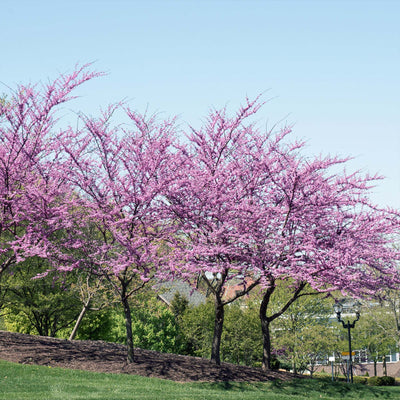Purple Trees for Sale Online
5 products
FREE Shipping on Orders Over $199
FREE Shipping on Orders Over $199
We’ve been growing landscape plants since 1980. We know it’s almost impossible to achieve a 100% survival rate. That’s why we’ve got you covered!
Our Perfect Plants 1 Year Warranty is roughly 10% of your plant total. It’s a cost-effective way to guarantee your plants for a full year.
If a plant dies up to 1 year after purchase, whether it's a weather related issue, human error, or anything else, just send us a picture at customerservice@myperfectplants.com and we’ll get you a store credit for the plant you purchased. The warranty does not cover the cost of shipping for any replacement.
Warranty must be purchased at the time of checkout and cannot be added after your order has been completed.
It’s that simple! Enjoy your new plants in confidence. Guarantee your plants for a full year today!
5 products
Purple trees have always been popular as yard trees. Lilacs are common in the Northeast, and crape myrtles are a Southern favorite. Some redbud trees bloom in royal hues of violet and lavender throughout much of the country. Breeders have developed burgundy and purple maple trees, shrubs, and plants.
When adding purple trees to your yard, it can be tempting to just plunk one down in an open spot. Take a moment to consider their appearance throughout the seasons and how they can be integrated into your overall landscape to achieve professional-looking results.
Some trees provide purple hues all season long, and some only for a few weeks during spring. When choosing purple flowering trees, pay attention to the color of the foliage as well as the blooms.
Some trees, like Japanese maples, crape myrtles, and some sugar maple cultivars, are available with darker foliage that leans toward purple.
Redbuds, crape myrtles like Black Diamond®, Jacaranda, a few crabapples, and other ornamentals bloom in purple hues, from pale lavender pinks to darker purples. They resume the appearance of a typical “green” tree once their flowering is over.
Using color strategically in your landscape can emphasize features, bring depth, and induce a ‘wow’ factor. Timing can also be important if you want your purple tree to contrast or complement another blooming plant. A fall-blooming yellow shrub won’t contrast with a spring-flowering redbud.
Keep in mind the color purple is not limited to trees. Many beautiful shrubs are available that either flower purple or have gorgeous purple foliage. Creating a multi-layer composition can enhance their effect.
Purple trees make great ornamental backdrops for perennial plant beds. They visually frame your entryway from the street or contrast a lower flowering shrub or garden.
Larger purple trees can make an impressive accent on your property. Whether standing stately and prominent in the front yard, flanking your mailbox, or guarding the ends of your porch or patio, purple trees are a statement. A huge flowering redbud in your yard will be the star of the neighborhood.
Purple trees and shrubs make excellent hedges as well. They provide great visual separation, breaking up the usual lines of green grass and plants. Use them as property borders, to separate garden rooms, line a driveway, or screen a garage or shed.
Since they stand out, a line of purple trees is an excellent way to draw the eye toward another object, like a gazebo, perennial garden, water feature, or patio.
Take advantage of the natural color contrasts available. Purple is the color opposite of yellow on the color wheel, meaning they are complementary, just like red and green. Yellow foliage and blooms are easier to find, so plan your purple plants and trees first. Purple contrasting buds and flowers make a dramatic and color-opposite contrast.
Subscribe Today & Save On Your First Order!












